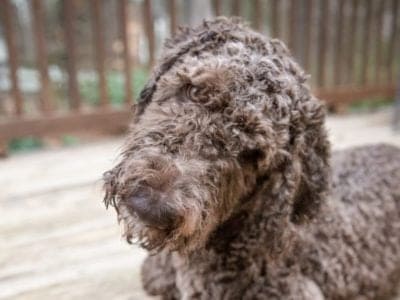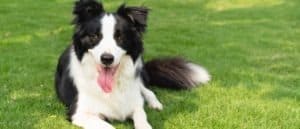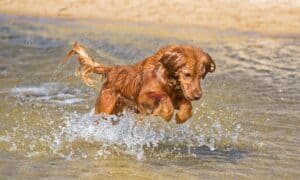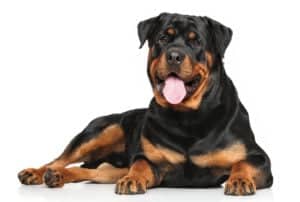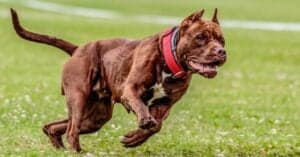Pyrenean Mastiff vs Great Pyrenees
@media (min-width: 481px) {
.mobile-top-content {
display: none;
}
}
#mobileTopContentCTACarouselControls { overflow: hidden; text-overflow: ellipsis; white-space: nowrap; }
.mobile-top-content .more { color: #fff; }
.mobile-top-content a { color: #fff; text-decoration: underline; }
.mobile-top-content a:hover { color: #fff; text-decoration: underline; }
@media (max-width: 480px) {
.mobile-top-content {
background-color: #06a10b;
color: #fff;
text-align: center;
/*height: 60px;
padding-top:5px;*/
font-size:80%;
/* display: block; */
margin: 0px -30px;
}
}
Pyrenean Mastiffs and Great Pyrenees are giant, fluffy, white dogs bred for guarding livestock. They’re closely related to one another.
However, these breeds have their differences. Pyrenean Mastiffs weigh up to 240 pounds! They have a variety of markings on their coat, are excellent with children, and live slightly longer than Great Pyrenees.
Keep reading to learn all the differences between these awesome breeds!
button.pulse {
transform: scale(1); animation: pulse 2s infinite;
box-shadow: 0 0 0 0 rgba(11, 247, 25, 1);
}
@keyframes pulse {
0% { transform: scale(0.90); box-shadow: 0 0 0 0 rgba(11, 247, 25, 0.5); }
60% { transform: scale(1); box-shadow: 0 0 0 15px rgba(11, 247, 25, 0); }
100% { transform: scale(0.90); box-shadow: 0 0 0 0 rgba(11, 247, 25, 0); }
}
Comparing Pyrenean Mastiffs vs Great Pyrenees
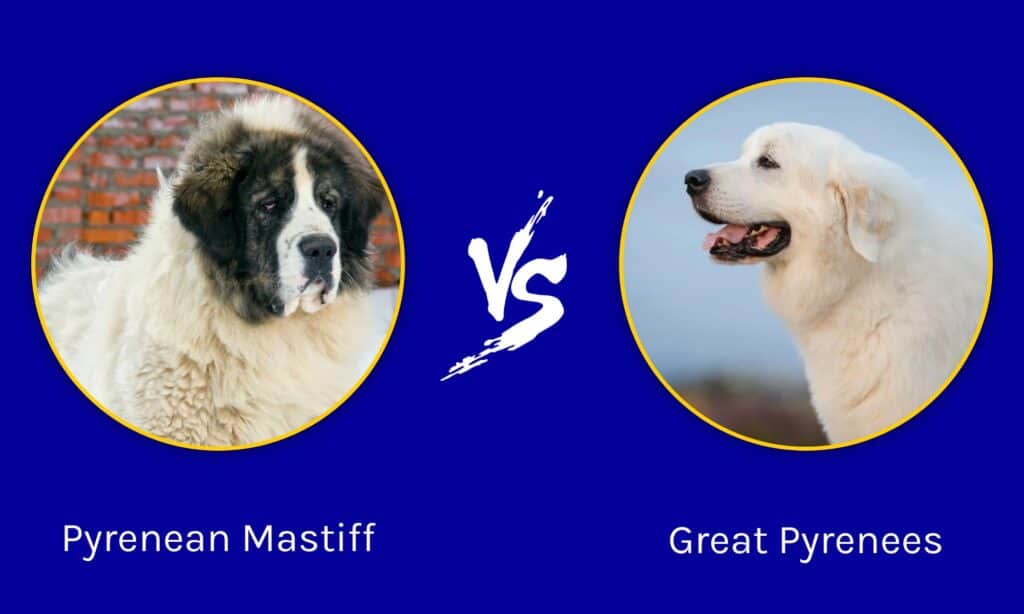
A-Z-Animals.com
| Pyrenean Mastiff | Great Pyrenees | |
|---|---|---|
| Size | 25-31 inches, 120-240 pounds | 25-32 inches, 85+ pounds |
| Coat | White coat paired with black, beige, brown, golden, grey, silver, or biscuit markings | White coat with tan, grey, badger, or reddish-brown markings |
| Lifespan | 8-12 years | 10-12 years |
| Tolerance to Children | Excellent with children | Can be good with children |
| Energy Level | Low | Average |
| Grooming | Every three days | Weekly |
| Drooling Level | Very high | Moderate |
| Barking Level | Low | Moderate |
The Key Differences Between Pyrenean Mastiffs and Great Pyrenees
The key differences between Pyrenean Mastiffs and Great Pyrenees are size, coat, lifespan, tolerance to children, energy level, grooming needs, drooling, and barking level.
Let’s look at these characteristics in-depth to learn more about these guardian breeds.
Pyrenean Mastiff vs Great Pyrenees: Size

AnjavdR/Shutterstock.com
When looking at height, there isn’t much difference between Pyrenean Mastiffs and Great Pyrenees. The smallest dogs of these breeds stand 25 inches tall. The largest Pyrenean Mastiffs are 31 inches, just an inch shorter than the tallest Great Pyrenees dogs.
However, there’s a great difference in the weight of these dogs. Though Great Pyrenees don’t have an upper weight limit, females start at 85 pounds, and males at 100 pounds. They aren’t likely to be over 200 pounds.
Pyrenean Mastiffs, by comparison, are giants! They can weigh anywhere from 120 to 240 pounds.
Pyrenean Mastiff vs Great Pyrenees: Coat
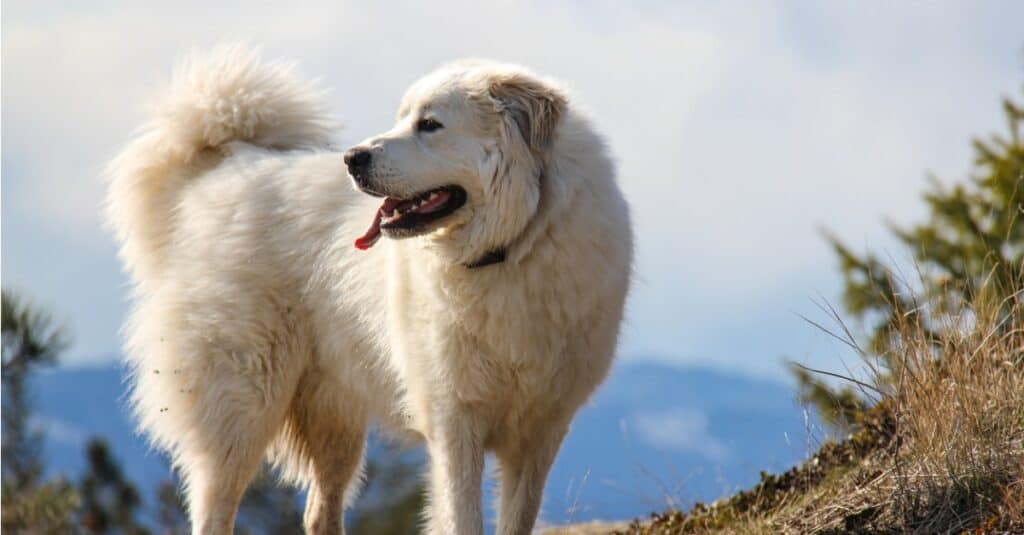
Both dogs have a fluffy white base coat. It is medium-length, and both breeds are double-coated.
However, their markings can vary. Here are the colors accepted by the Pyrenean Mastiff breed standard:
- White and beige
- White and black
- White and brown
- White and golden
- White and grey
- White and silver
- White and biscuit
Patched and brindle markings are accepted.
The only color listed under the Great Pyrenees breed standard is white. However, the following markings are allowed:
- Tan
- Grey
- Badger
- Reddish-brown
Pyrenean Mastiff vs Great Pyrenees: Lifespan
Pyrenean Mastiffs live slightly shorter lives on average, spanning from 8 to 12 years. Great Pyrenees typically live 10-12 years.
Pyrenean Mastiff vs Great Pyrenees: Tolerance to Children
Pyrenean Mastiffs are known for being excellent with children, though every dog is different! They tend to be gentle giants and incredibly tolerant.
Great Pyrenees dogs are family-loving. If you have a child in the family, they’re sure to bond with and love them. However, they may be stand-offish toward strangers, which can include children they don’t know.
With any dog, especially a giant breed, it’s important to teach proper manners. Never allow them to jump on people, even as puppies, as bad habits like this can be hard to break in adulthood.
Children should also be taught proper behavior and gentleness with dogs. Don’t let them touch the dog’s food, get in their face while eating, or climb on the dog’s back. They should pet dogs gently and never hit or tug on them.
Always supervise children and dogs together. Even if you trust them both, mistakes can happen, and someone can end up hurt!
Pyrenean Mastiff vs Great Pyrenees: Energy Level
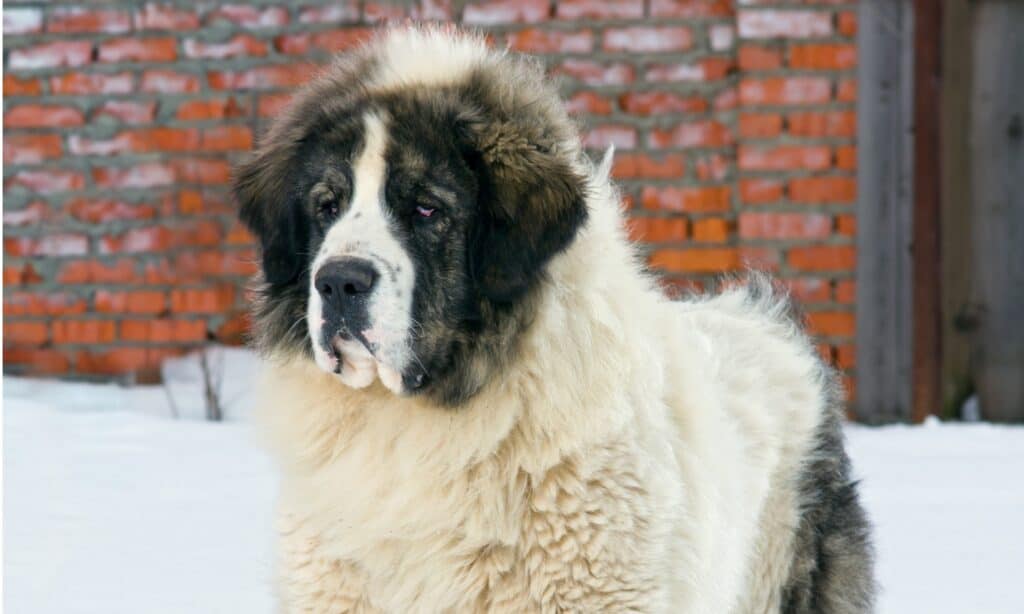
iStock.com/Laures
Pyrenean Mastiffs are low-energy dogs. Like any dog, they still need exercise. They benefit from several short walks throughout the day and playtime in the backyard. Due to their size, their joints are fragile. The AKC recommends against walking them on cement and notes that long walks can be detrimental to a puppy’s growth and health.
Great Pyrenees have slightly higher energy, but they’re built more for endurance than sprints. It’s in their nature to conserve energy, as they’d need it to save livestock from threats. They need at least one long daily walk and benefit from playtime in the backyard as well. Like Pyrenean Mastiffs, Great Pyrenees are giant dogs, and you should take caution not to over-exercise them as puppies.
Pyrenean Mastiff vs Great Pyrenees: Grooming Needs
Pyrenean Mastiffs are higher-maintenance in the grooming department, though they tend to shed less than Great Pyrenees. Their coat should be brushed once every three days to prevent mats and tangles. Check them regularly for mats in commonly-tangled, harder-to-reach places like under the armpits and between the toes.
Great Pyrenees dogs have coats that resist matting and dirt, but they still require care. Brush them once weekly to remove any snags and to distribute their natural oils. This will keep the coat looking healthy and sleek. Regular brushing will also lessen the shed you’ll see from your Great Pyr year-round.
Pyrenean Mastiff vs Great Pyrenees: Drooling Level

iStock.com/ktatarka
Great Pyrenees are moderate droolers. You may have to wipe their face occasionally and clean regularly beneath the water bowl. They might also drool on the floors, furniture, or people—particularly when they’re begging for a treat!
Pyrenean Mastiffs are even heavier droolers, and you’ll definitely have to keep up with wiping their mouths and cleaning up behind them.
Pyrenean Mastiff vs Great Pyrenees: Barking Level
It’s unlikely that your Pyrenean Mastiff will develop problem barking behaviors. They typically bark only to alert. Great Pyrenees dogs are moderate barkers and more likely to bark excessively. If your dog barks too much, this can be a result of training or boredom.
Start by ensuring they’re getting plenty of attention and exercise. Next, make sure your dog hasn’t developed separation anxiety, and they aren’t being left alone for great lengths of time. Lastly, teach your dog to speak. Yes, you heard that right!
You want your dog to bark on command so that their barking is somewhat under control. Then, you can give the command and praise your dog when they stop barking. This is the beginning of teaching a “quiet” command.
Once your dog has it down, you’ll be able to shush them easily when the mailman arrives, saving your eardrums from their loud barks!
Ready to discover the top 10 cutest dog breeds in the entire world?
How about the fastest dogs, the largest dogs and those that are — quite frankly — just the kindest dogs on the planet? Each day, AZ Animals sends out lists just like this to our thousands of email subscribers. And the best part? It’s FREE. Join today by entering your email below.
More from A-Z Animals
.more-snake-card-image { max-height:140px !important; }
@media (min-width: 481px) {
.mobile-top-content {
display: none;
}
}
#mobileTopContentCTACarouselControls { overflow: hidden; text-overflow: ellipsis; white-space: nowrap; }
.mobile-top-content .more { color: #fff; }
.mobile-top-content a { color: #fff; text-decoration: underline; }
.mobile-top-content a:hover { color: #fff; text-decoration: underline; }
@media (max-width: 480px) {
.mobile-top-content {
background-color: #06a10b;
color: #fff;
text-align: center;
/*height: 60px;
padding-top:5px;*/
font-size:80%;
/* display: block; */
margin: 0px -30px;
}
}
Pyrenean Mastiffs and Great Pyrenees are giant, fluffy, white dogs bred for guarding livestock. They’re closely related to one another.
However, these breeds have their differences. Pyrenean Mastiffs weigh up to 240 pounds! They have a variety of markings on their coat, are excellent with children, and live slightly longer than Great Pyrenees.
Keep reading to learn all the differences between these awesome breeds!
button.pulse {
transform: scale(1); animation: pulse 2s infinite;
box-shadow: 0 0 0 0 rgba(11, 247, 25, 1);
}
@keyframes pulse {
0% { transform: scale(0.90); box-shadow: 0 0 0 0 rgba(11, 247, 25, 0.5); }
60% { transform: scale(1); box-shadow: 0 0 0 15px rgba(11, 247, 25, 0); }
100% { transform: scale(0.90); box-shadow: 0 0 0 0 rgba(11, 247, 25, 0); }
}
Comparing Pyrenean Mastiffs vs Great Pyrenees

A-Z-Animals.com
| Pyrenean Mastiff | Great Pyrenees | |
|---|---|---|
| Size | 25-31 inches, 120-240 pounds | 25-32 inches, 85+ pounds |
| Coat | White coat paired with black, beige, brown, golden, grey, silver, or biscuit markings | White coat with tan, grey, badger, or reddish-brown markings |
| Lifespan | 8-12 years | 10-12 years |
| Tolerance to Children | Excellent with children | Can be good with children |
| Energy Level | Low | Average |
| Grooming | Every three days | Weekly |
| Drooling Level | Very high | Moderate |
| Barking Level | Low | Moderate |
The Key Differences Between Pyrenean Mastiffs and Great Pyrenees
The key differences between Pyrenean Mastiffs and Great Pyrenees are size, coat, lifespan, tolerance to children, energy level, grooming needs, drooling, and barking level.
Let’s look at these characteristics in-depth to learn more about these guardian breeds.
Pyrenean Mastiff vs Great Pyrenees: Size

AnjavdR/Shutterstock.com
When looking at height, there isn’t much difference between Pyrenean Mastiffs and Great Pyrenees. The smallest dogs of these breeds stand 25 inches tall. The largest Pyrenean Mastiffs are 31 inches, just an inch shorter than the tallest Great Pyrenees dogs.
However, there’s a great difference in the weight of these dogs. Though Great Pyrenees don’t have an upper weight limit, females start at 85 pounds, and males at 100 pounds. They aren’t likely to be over 200 pounds.
Pyrenean Mastiffs, by comparison, are giants! They can weigh anywhere from 120 to 240 pounds.
Pyrenean Mastiff vs Great Pyrenees: Coat

Both dogs have a fluffy white base coat. It is medium-length, and both breeds are double-coated.
However, their markings can vary. Here are the colors accepted by the Pyrenean Mastiff breed standard:
- White and beige
- White and black
- White and brown
- White and golden
- White and grey
- White and silver
- White and biscuit
Patched and brindle markings are accepted.
The only color listed under the Great Pyrenees breed standard is white. However, the following markings are allowed:
- Tan
- Grey
- Badger
- Reddish-brown
Pyrenean Mastiff vs Great Pyrenees: Lifespan
Pyrenean Mastiffs live slightly shorter lives on average, spanning from 8 to 12 years. Great Pyrenees typically live 10-12 years.
Pyrenean Mastiff vs Great Pyrenees: Tolerance to Children
Pyrenean Mastiffs are known for being excellent with children, though every dog is different! They tend to be gentle giants and incredibly tolerant.
Great Pyrenees dogs are family-loving. If you have a child in the family, they’re sure to bond with and love them. However, they may be stand-offish toward strangers, which can include children they don’t know.
With any dog, especially a giant breed, it’s important to teach proper manners. Never allow them to jump on people, even as puppies, as bad habits like this can be hard to break in adulthood.
Children should also be taught proper behavior and gentleness with dogs. Don’t let them touch the dog’s food, get in their face while eating, or climb on the dog’s back. They should pet dogs gently and never hit or tug on them.
Always supervise children and dogs together. Even if you trust them both, mistakes can happen, and someone can end up hurt!
Pyrenean Mastiff vs Great Pyrenees: Energy Level

iStock.com/Laures
Pyrenean Mastiffs are low-energy dogs. Like any dog, they still need exercise. They benefit from several short walks throughout the day and playtime in the backyard. Due to their size, their joints are fragile. The AKC recommends against walking them on cement and notes that long walks can be detrimental to a puppy’s growth and health.
Great Pyrenees have slightly higher energy, but they’re built more for endurance than sprints. It’s in their nature to conserve energy, as they’d need it to save livestock from threats. They need at least one long daily walk and benefit from playtime in the backyard as well. Like Pyrenean Mastiffs, Great Pyrenees are giant dogs, and you should take caution not to over-exercise them as puppies.
Pyrenean Mastiff vs Great Pyrenees: Grooming Needs
Pyrenean Mastiffs are higher-maintenance in the grooming department, though they tend to shed less than Great Pyrenees. Their coat should be brushed once every three days to prevent mats and tangles. Check them regularly for mats in commonly-tangled, harder-to-reach places like under the armpits and between the toes.
Great Pyrenees dogs have coats that resist matting and dirt, but they still require care. Brush them once weekly to remove any snags and to distribute their natural oils. This will keep the coat looking healthy and sleek. Regular brushing will also lessen the shed you’ll see from your Great Pyr year-round.
Pyrenean Mastiff vs Great Pyrenees: Drooling Level

iStock.com/ktatarka
Great Pyrenees are moderate droolers. You may have to wipe their face occasionally and clean regularly beneath the water bowl. They might also drool on the floors, furniture, or people—particularly when they’re begging for a treat!
Pyrenean Mastiffs are even heavier droolers, and you’ll definitely have to keep up with wiping their mouths and cleaning up behind them.
Pyrenean Mastiff vs Great Pyrenees: Barking Level
It’s unlikely that your Pyrenean Mastiff will develop problem barking behaviors. They typically bark only to alert. Great Pyrenees dogs are moderate barkers and more likely to bark excessively. If your dog barks too much, this can be a result of training or boredom.
Start by ensuring they’re getting plenty of attention and exercise. Next, make sure your dog hasn’t developed separation anxiety, and they aren’t being left alone for great lengths of time. Lastly, teach your dog to speak. Yes, you heard that right!
You want your dog to bark on command so that their barking is somewhat under control. Then, you can give the command and praise your dog when they stop barking. This is the beginning of teaching a “quiet” command.
Once your dog has it down, you’ll be able to shush them easily when the mailman arrives, saving your eardrums from their loud barks!
Ready to discover the top 10 cutest dog breeds in the entire world?
How about the fastest dogs, the largest dogs and those that are — quite frankly — just the kindest dogs on the planet? Each day, AZ Animals sends out lists just like this to our thousands of email subscribers. And the best part? It’s FREE. Join today by entering your email below.







